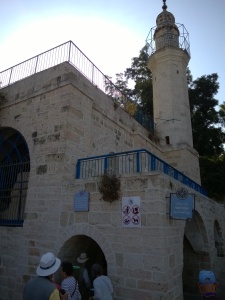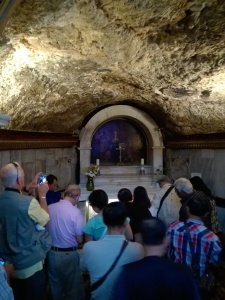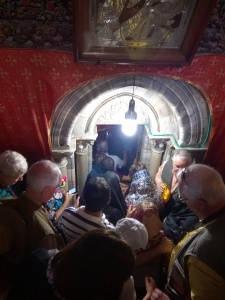We began our day with a visit to Ein Karem, which was John the Baptist’s birthplace (Luke 1:39-45). A variety of churches commemorating his birth and memory have been built here.
And, as in many areas, landmarks of Judaism, Christianity, and Islam often stand side by side. Here in this Jewish town stand a mosque (far left above) and a church (far right up the hillside).
Under this mosque is a site important to Christians. The Spring of Mary. Late tradition (14th century) holds that Mary drank from this spring and met with Elizabeth at this location. The waters are considered to be holy. Our guide, Yoel, confirmed that this spring does have power of which he is personally aware. Anyone who drinks from these waters will be blessed with a trip to the local hospital due to waterborne illnesses. We didn’t feel the need for such blessings and abstained.
Just up the road, is the Church of St. John the Baptist. It is a Catholic church built atop a Crusader era church built atop a Byzantine church built atop a cave in which the Baptizer was said to have been born.
Even at a glace, one can see various styles of construction on the exterior.
Surrounding the courtyard are displays of the Zechariah’s prophecy about Jesus during Mary’s visit (Luke 1:67-79) written in many languages of the world.
Inside, the church is beautiful and ornate.
Off to one side is an archway leading to stairs.
The stairs go down to a chapel/altar.
Under the altar is the traditional location for John’s birth. Many other pilgrims were glad to crawl down there and lay hands on the place. Some did so prayerfully. Others looked more like they were worshipping an idol. While the extreme devotion of relics seems at odds with God’s call not to employ images for worship (and certainly we are not to worship the relics themselves!); nevertheless, it seems quite common in the sites with long standing traditions like this.
Can anyone say, “Trademark infringement?”
The parking lot to the Church of the Nativity. Jammed with people and cars. This basilica was originally commissioned by Constantine’s mother in the 300’s A.D. over the cave traditionally considered to be the birth place of Jesus.
The entrance is designed for the humble. And hobbits.
The interior is said to be spectacular, but it is undergoing renovations and most of it can’t be seen.
More can be seen in the Greek Orthodox controlled portion (they with the Catholics and the Armenians each control some of this site) shows the ornate and decorative style of the Orthodox.
Large chandeliers donated by a big-wig Czar from Russia (Peter?? Can’t remember). Not sure why they’ve already begun hanging Christmas decorations. Maybe to get a jump on Walmart. Note the “candles” in use. They might be from the Byzantine era, but we aren’t sure.
Icons, icons, icons!
After 30-40 minutes of waiting in line, we are ready to be funneled down below the chancel of the basilica.
Those looking right are seeing the spot Jesus is said to have been born. Those looking to the left are seeing the site the manger was supposedly occupying.
So, there’s the traditional birth place of Jesus. Pastor Phil told me it was actually 3.7 inches to the right, but they didn’t want to move the whole basilica.
And the place of the manger. There is some amazing history built up in these places and there any many ancient traditions pointing to these locations in general for the events in question. The skeptic in me does come out a bit when they narrow it down to a 4 foot (or 4 inch) location. Still, if you want to commemorate the event, I suppose you do need to pick a place to do so.
Next stop was the shepherd’s fields. Here is a mystery picture of a hole in the ground with a bunch of rocks in it. Actually, 41% of the pictures we take look just like this. (Another 49% are of hills rising up covered with rocks). Later, when we get back to the hotel and sort through our photos for the day, we can’t remember why we took a picture of that particular pile of rocks (be they in a hole or on a hill). This is our way of sharing the confusion with you.
Here we visited a cave in the hillside that, despite some chapel-like additions, still felt very much like the cave it was. It is likely that shepherd watching their flocks would make use of these caves for protection from the elements and predators. The shepherd could place the flock into the cave and lay across the entrance to guard the sheep within. Such an image adds new meaning to Jesus’ words, “I am the gate.”
There was a chapel here at the shepherd’s fields and while it may not have had the best acoustics in the whole land, they were still very good. Obviously, we broke into song. Quite a few of the other visitors were from Minnesota and were Lutherans (of a different stripe). While we probably would take issue with aspects of their theology, they still new how to sing, as any Lutheran should, and, soon adding their voices to ours, the place rang out with the hymns of old.
That’s not the sun or the moon, but the flash reflected in the van window, looking out across the many still undeveloped hills where the shepherds who proclaimed Jesus’ birth to all who would listen tended their flocks 2000 years ago.

























[…] Day 7 – https://eslc.wordpress.com/2015/11/02/day-seven-ein-karem-bethlehem-herodian/ […]
LikeLike